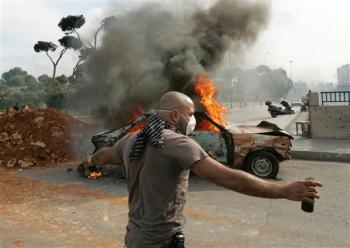Wednesday, May 7, 2008

An opposition protester holds a gazoline bottle
as he stands near a burning car during a protest called by
labor unions in Beirut, Lebanon, Wednesday, May 7, 2008.
BEIRUT, Lebanon (AP) — Lebanon's long-simmering political crisis erupted into gunfire and explosions Wednesday when a labor strike devolved into clashes between rival Hezbollah and government supporters.
Demonstrators supported by militant Hezbollah protested the U.S.-backed government's economic policies and paralyzed much of Beirut with roadblocks of burning tires. The strike turned violent when both sides began throwing stones at each other, and gunfire and explosions rang out in some areas for brief periods.
The cause of the explosions was not immediately known. There were a few injuries reported, mostly from the stone throwing.
The clashes threatened to degenerate into an all-out sectarian conflict. Shiite Hezbollah seized the offices of a major Sunni group and the fighting spread to several mixed Sunni-Shiite neighborhoods.



I like the "US-backed" bit. Technically true, I suppose, but it seems a bit forced.
I noticed that too. Then there's the fact that most of the photographs seemed to be taken by someone who was running with Hezbollah
- and the fact that the photo of the guy throwing 'gazoline' was fairly well centered, almost posed
- also, "an Associated Press photographer" saw "gunmen from Hezbollah and the allied Shiite Amal group controlled by Parliament Speaker Nabih Berri shooting toward one of the buildings housing Hariri's Future Movement office." (again, from Hezbollah's point of view)
Michael Young and the AP reporter seem to be talking about entirely different conflicts. Honestly, I think al Jazeera's report was less biased than AP.